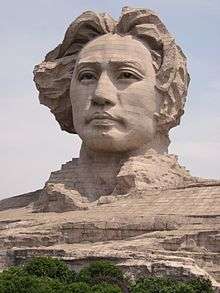Orange Isle
| Orange Isle | |||||||
| Traditional Chinese | 橘子洲 | ||||||
|---|---|---|---|---|---|---|---|
| Simplified Chinese | 橘子洲 | ||||||
| |||||||
| Orange Isle | |||||||
| Traditional Chinese | 桔子洲 | ||||||
|---|---|---|---|---|---|---|---|
| Simplified Chinese | 桔子洲 | ||||||
| |||||||
Coordinates: 28°11′03″N 112°57′41″E / 28.184121°N 112.96129°E
Orange Isle is a isle in Xiang River, Changsha, Hunan, China.[1] It also known by other names, such as Ju Isle (Chinese: 桔洲; Chinese: 橘洲) and Shuilu Isle (simplified Chinese: 水陆洲; traditional Chinese: 水陸洲). It has a length of 5 km and a width of 50–200 meters and a total area of 70 km.[2] It consists of three nearly-connected isles: upper isle, middle isle and lower isle. It is a well-known scenic spot in China and widely known worldwide.[2]
History
Orange Isle was first mentioned in 305, during the Yongxing era of the reign of Emperor Hui of Jin during the Jin Dynasty (265-420).[3]
In Tang Dynasty, poet Du Fu wrote a poem Visiting Daolin Temple and Yuelushan Temple (simplified Chinese: 岳麓山道林二寺行; traditional Chinese: 嶽麓山道林二寺行), which mentioned Orange Isle. It had been on the list of The Eight Views of Xiaoxiang - River and Sky: Sunset Snow.
Orange Isle was opened in 1904, during the late Qing Dynasty.[3]
From 1911 to 1949, many foreign embassies and consulates was built on the isle.[3]
During Mao Zedong's early years, he lived in Changsha, he and his friends He Shuheng, Xiao Zisheng, Cai Hesen, Xiao San and Xiang Jingyu walked on the isle and swam in Xiang River.[2][4]
Since 2010s, the Orange Isle Music Festival is host on the isle.[5][6][7][8]
On December 20, 2009, the Youth Mao Zedong Statue was built on the isle.[9][10]
Attractions
- Hunan Culture Corridor
- On-water Amusement Corridor
- Orange Garden
- Garden of the Nature
- Park of Harmonious Guests
- Plaza of Shopping and Foods
- GYM Center
- Relaxation Resort
- Wildlife Park
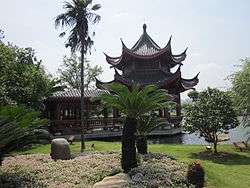 A pavilion. |
 Statues of Notable Hunan people. |
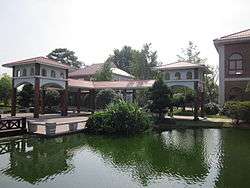 |
 |
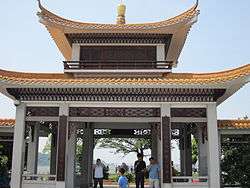 Wangjiang Pavilion. |
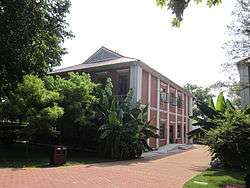 |
 |
 |
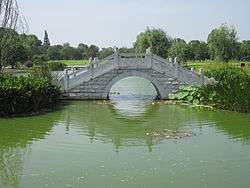 |
Traffic
References
- ↑ "Orange Isle to Hold the Opening Ceremony of Hunan International Tourism Festival". Retrieved 2009.
- 1 2 3 "Changsha Orange Isle". Retrieved 2012.
- 1 2 3 140年前的水陆洲,江神庙、拱极楼曾热闹非凡续 (in Chinese). Xinhua. Retrieved 2013.
- ↑ 伟人伫立橘洲头 毛泽东雕像背后的故事 (in Chinese). Ifeng. Retrieved 2009.
- ↑ "Orange Isle Music Festival kick off in C China". Xinhua. Retrieved 2010.
- ↑ "2013 Orange Isle Music Festival to Rock Changsha Sept 8-9". Retrieved 2013.
- ↑ "the 2012 Orange Isle Music Festival". Retrieved 2012.
- ↑ "3rd Orange Isle Music Festival". Retrieved 2013.
- ↑ 32米高青年毛泽东像矗立橘子洲头 (in Chinese). Ifeng. Retrieved 2009.
- ↑ 毛泽东诞辰116周年:橘子洲毛泽东雕塑揭幕 (in Chinese). Red.net. Retrieved 2009.
External links
| Wikimedia Commons has media related to Orange Isle. |
